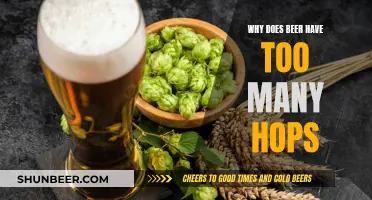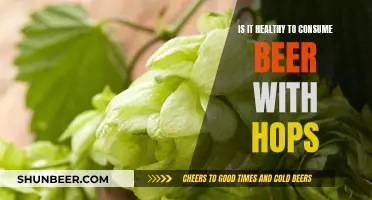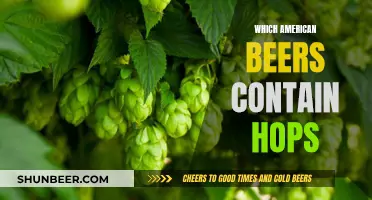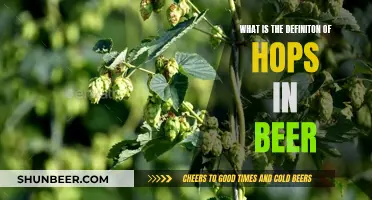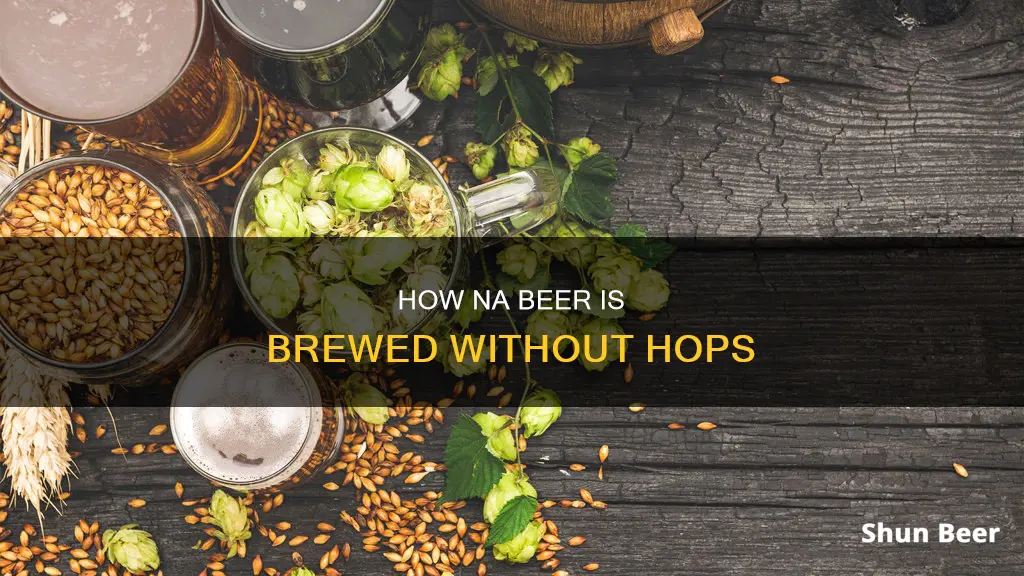
Non-alcoholic (NA) beer has gained popularity in recent years, with craft NA brewing making it a viable option for beer enthusiasts. The question remains, however, whether NA beer contains hops. Hops are the flowers of the hop plant, Humulus lupulus, and are used primarily for bittering, flavouring, and stabilising beer. They are typically added during the boil stage of brewing, as it takes around an hour to release the bittering alpha acids. While hops are indeed one of the essential ingredients in regular beer, it is not a given that they are used in NA beer. So, does NA beer contain hops?
| Characteristics | Values |
|---|---|
| Main ingredients | Hops, carbonated water |
| Additional ingredients | Brewer's yeast, grapefruit juice, orange juice |
| Flavours | Citrus, floral, fruity, herbal, piney, tropical |
| Calories | 0-90 |
| Carbohydrates | 0-21g |
What You'll Learn

NA beers can be very good
In the past, non-alcoholic beers were often tasteless and lacked flavour. However, thanks to a recent rise in craft NA brewing, NA beers have improved in taste and style diversity. They now come in a range of options, including lagers, IPAs, and stouts.
The NA beer sector has boomed in the last five years, and experts predict further growth. Beer giant AB InBev, for example, has set a goal for at least 20% of its global beer volume to be no- or low-alcohol by 2025.
NA beers are a great way for individuals to reduce their alcohol intake while still enjoying the taste and experience of beer. They also tend to be lower in calories than regular beer. For instance, Athletic Brewing's Upside Dawn beer has only 50 calories and 12 grams of carbs per 12-ounce can, whereas a can of Budweiser has 146 calories and 10.6 grams of carbs.
Some of the best NA beers include:
- Guinness 0: This NA beer is very similar in taste to the alcoholic version, delivering the same rich, creamy satisfaction.
- Athletic Brewing All Out Extra Dark: This beer mimics the taste of a real-deal stout, with notes of roasted nuts and coffee.
- Al's Classic Non-Alcoholic Lager: With a crisp and clean taste and none of the odd aftertaste common in lighter NA beers, this lager is a great option for Bud Light drinkers.
- Heineken Non-Alcoholic 0.0: Diehard fans of the original Heineken might not mistake this for a classic Heineken, but it does have that characteristic skunkiness and mouthfeel.
- Brooklyn Special Effects Hoppy Amber Non-Alcoholic Brew: This citrusy and well-rounded lager is dry-hopped for just the right amount of bitterness.
- Untitled Art Non-Alcoholic West Coast IPA: With Cascade, Centennial, and Simcoe hops, this NA beer is hoppy and bitter with just the right amount of body and heft.
So, if you're looking for a drink that's lower in calories and alcohol content but still packed with flavour, give NA beers a try!
Hops in Beer: Necessary or Overrated?
You may want to see also

Hop water is a thing
Hop water is a non-alcoholic beverage made by mixing carbonated water, hops, and occasionally added flavorings. It's a great alternative to beer, especially for those looking to cut down on their alcohol intake, without compromising on the refreshing taste of hops.
The Rise of Hop Water
The first hop water, created by a brand called H2OPS, was launched in 2014, and since then, the category has grown significantly. Between August 2021 and August 2022, hop waters generated $5.5 million in sales, a surge of 142.5% from the previous year. The category climbed to the fifth-biggest growing craft-style beverage in the U.S., with sales increasing by almost 44% in the same period.
For beer lovers, hop water offers a way to consume the flavor of hops without the alcohol and calories that come with beer. It's a crisp, refreshing drink that delivers a hint of what people love about beer, without the side effects of alcohol.
Who's Making It?
Several notable craft breweries have entered the hop water market, including Sierra Nevada, Lagunitas, Athletic Brewing Company, and Great Notion. Sierra Nevada's Hop Splash, for example, is made with Citra and Amarillo hops, while Lagunitas' Hoppy Refresher has been a pioneer in the category since its release in 2018.
Creating hop water at home is a simple process. All you need is good drinking water, hops (commonly Citra, Mosaic, or Cascade varieties), and optionally, some gypsum. You combine these ingredients, let them sit for about 24 hours, and then filter and carbonate the mixture. The result is a refreshing, hop-infused drink.
The Future of Hop Water
With the continued growth of the non-alcoholic beverage market, it's clear that hop water is here to stay. As more people seek alternatives to alcohol, whether for health, lifestyle, or curiosity, hop water presents a unique and appealing option. It offers a pure expression of hops and showcases the diverse flavors and aromas that these flowers can impart.
So, if you're a beer lover looking for a daytime drink or an alternative to alcohol, hop water is definitely worth a try. It's a growing trend that combines the best of craft beer and sparkling water, offering a crisp, flavorful, and healthy beverage.
Guinness Beer's Hoppy Secret: A Complex Blend
You may want to see also

Hops are flowers
Hops are used primarily as a bittering, flavouring, and stability agent in beer. They impart floral, fruity, or citrus flavours and aromas to beer. Hops also have antibacterial effects, suppressing the growth of undesirable microorganisms and favouring the growth of brewer's yeast.
In addition to their use in beer, hops are used for various purposes in other beverages and herbal medicine. They have been used medicinally for more than 2,000 years to help manage a variety of ailments, including sleep problems and anxiety. Hops are also said to promote healthy relaxation, improve mood, and support immune health.
The first documented use of hops in beer was in the 9th century, although Hildegard of Bingen in the 12th century is often cited as the earliest documented source. Hops have been used for centuries to flavour beer and are intertwined with the lore of beer and brewing.
Icehouse Beer: Hops or No Hops?
You may want to see also

Hops are added to the boil stage of brewing
During the boil, hops are typically added in 3 stages: bittering, flavour, and aroma. These stages are related to the role they play in the beer, rather than the type of hop. That means the same hop variety can be used for bittering, flavouring, and aroma.
Bittering hops are added once the wort has been collected in the kettle and a rolling boil has been achieved. They are usually boiled for 60 minutes, though some recipes may call for as little as 30 minutes. All beers have bittering hops to balance the sweetness of the malt.
Flavouring hops are added with between 15 and 30 minutes remaining in the boil. During this time, very little bitterness will be extracted, but the crisp hoppy flavour will be imparted.
Aroma hops are added during the last 5 minutes of the boil or at flame out (when the kettle is removed from the heat). This is because the hop oils responsible for aroma are extremely volatile and will be driven off in the steam of the boil almost immediately. Adding hops at flame out will produce the maximum amount of aroma.
The Essential Ingredient in Beer: Hops or Not?
You may want to see also

Hops are used for medicine
Hops are used for a variety of medicinal purposes, including:
Anxiety, Sleep Disorders, and Restlessness
Hops are often used to treat anxiety, sleep disorders, and restlessness. The chemicals in hops act similarly to the hormone estrogen and can cause sleepiness. Some studies have shown that non-alcoholic beer with hops can help people fall asleep faster and reduce anxiety levels.
Menopause and Hormone Replacement Therapy
Hops contain the flavonoid 8-prenylnaringenin, which is a phytoestrogen—a plant-based compound that mimics the activity of the female hormone estrogen. This can help increase estrogenic activity in the body and alleviate symptoms of menopause, such as hot flashes.
Cardiovascular Disease
Hops contain the flavonoid xanthohumol, which is believed to help relax blood vessels and improve blood circulation. Animal studies have shown that xanthohumol may play a role in reducing the risk of cardiovascular disease by reducing calcification in arteries and veins.
Cancer
Xanthohumol, a compound found in hops, has been found to kill various types of cancer cells in test tube studies. It triggers apoptosis, or programmed cell death, and displays anticancer effects.
Depression and Mood Disorders
A small study found that hops supplementation significantly reduced anxiety, stress, and depression levels in young adults with mild depression. Hops may have potential as a treatment for depression and other mood disorders.
Hemp and Hops: Exploring the Botanical Cousins
You may want to see also
Frequently asked questions
Non-alcoholic beer, or NA beer, is beer that contains little to no alcohol. NA beer has become increasingly popular in recent years, with many craft breweries offering NA options that taste just as good as their alcoholic counterparts.
Yes, NA beer typically contains hops. Hops are the flowers of the hop plant (Humulus lupulus) and are used to add bitterness, flavour, and stability to beer. They also have antibacterial effects and help to extend the shelf life of beer.
Hops add flavour and bitterness to NA beer, making it more palatable and enjoyable to drink. They also provide some of the same health benefits as alcoholic beer, such as potential anxiety relief and improved sleep.
Yes, while most NA beers contain hops, there are some options without hops. For example, Lagunitas Hop Refresher Sparkling Water is a hop-infused seltzer that does not contain any beer.




